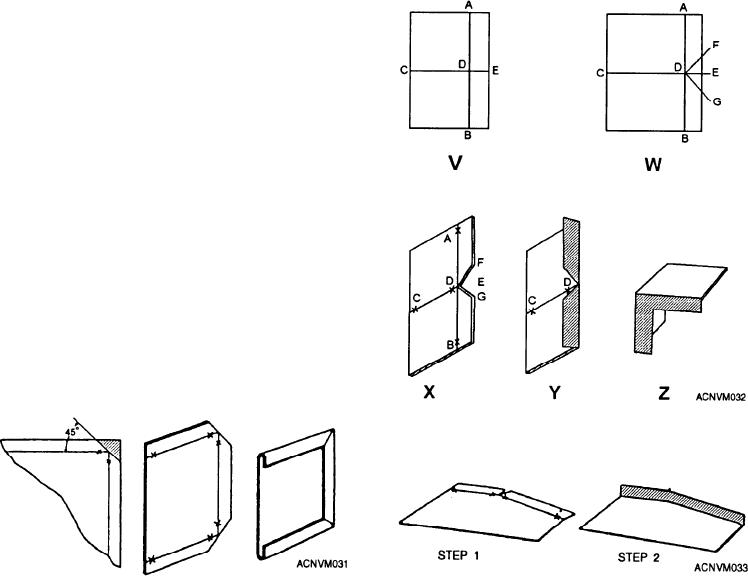
you are laying out the pocket, and 3/16 inch on your top
Your first 90-degree bends will be on line ADB, and
the next ones will be on line CDE. But before you can
piece for the flanged edge.
make your bends, you will have to make your notch.
LAYING OUT NOTCHES
To make your notch, lay out your dimensions for
the length and the width. Make sure you include the
Notching is the last but not the least important step
width the flange in your layout. Next lay out line
to be considered when you lay out a job. A notch is the
ADB, which will be the width of the flange. Then lay
out line CDE where your main bend will be, as shown
spot on a piece of sheet metal that is cut out to allow the
in part V of figure 12-32. Next, bisect angles ADE and
forming of a bend without the metal binding. Before
BDE on the flange, as shown in part W. Your final step
you can mark a notch, you will have to lay out the
prior to bending is to cut out your V-notch (angle FDG),
pattern and add the seams, laps, or stiffening edges. If
as shown in part X of figure 12-32. Views Y and 2 show
the patterns are not properly notched, you will have
the bends being made.
trouble when you start forming, assembling, or
finishing the job.
When you are making an inside flange on an angle
of MORE or LESS than 90 degrees, you will have to
There is no definite rule for selecting the proper
use a modification of the full V-notch to get flush joints.
notch for the job. But as soon as you can visualize the
The angle of the notch will depend upon the bend angle.
assembly of the job, you will have no trouble
A modified V-notch is shown in figure 12-33.
determining the shape of the appropriate notch. If the
notch is made too large, a hole will be left in the finished
job. If the notch is too small, or not of the proper shape,
the metal will overlap and bulge at the seam or edge. Do
not worry too much if your first notches do not come
out very well; practice and experience will take care of
that.
A SQUARE NOTCH is probably the first one you
will make. That is the kind you were instructed to make
in your practice layout of a box or drip pan. Take a look
around the shop to see just how many different kinds of
notches you can see in the sheet metal shapes.
SLANT NOTCHES are cut at a 45-degree angle
across the corner, when a single hem is to meet at a
90-degree angle. Figure 12-31 shows the steps in
forming a slant notch.
A V-NOTCH is used to seam the ends of boxes. You
will also use a full V-notch when you construct a bracket
with a toed-in flange or for similar construction. The
full V is shown in figure 12-32.
Figure 12-32.--V-notch.
Figure 12-33--Modified V-notch.
Figure 12-31.--Slant notch.
12-11

